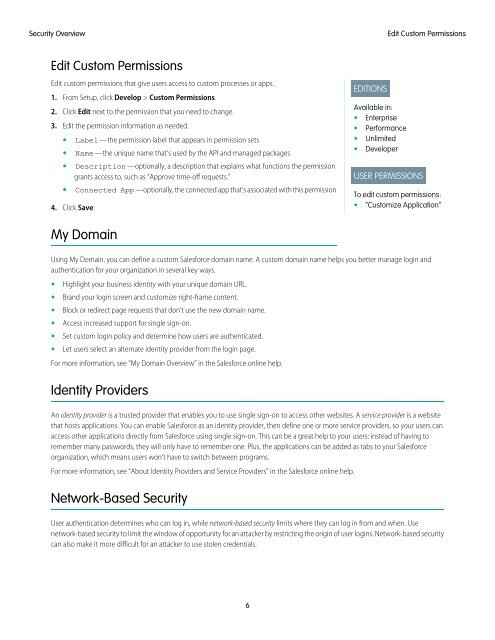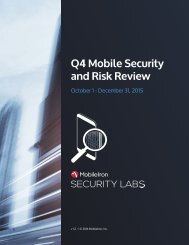salesforce_security_impl_guide
salesforce_security_impl_guide
salesforce_security_impl_guide
You also want an ePaper? Increase the reach of your titles
YUMPU automatically turns print PDFs into web optimized ePapers that Google loves.
Security Overview<br />
Edit Custom Permissions<br />
Edit Custom Permissions<br />
Edit custom permissions that give users access to custom processes or apps.<br />
1. From Setup, click Develop > Custom Permissions.<br />
2. Click Edit next to the permission that you need to change.<br />
3. Edit the permission information as needed.<br />
• Label—the permission label that appears in permission sets<br />
• Name—the unique name that’s used by the API and managed packages<br />
• Description—optionally, a description that explains what functions the permission<br />
grants access to, such as “Approve time-off requests.”<br />
• Connected App—optionally, the connected app that’s associated with this permission<br />
4. Click Save.<br />
EDITIONS<br />
Available in:<br />
• Enterprise<br />
• Performance<br />
• Unlimited<br />
• Developer<br />
USER PERMISSIONS<br />
To edit custom permissions:<br />
• “Customize Application”<br />
My Domain<br />
Using My Domain, you can define a custom Salesforce domain name. A custom domain name helps you better manage login and<br />
authentication for your organization in several key ways.<br />
• Highlight your business identity with your unique domain URL.<br />
• Brand your login screen and customize right-frame content.<br />
• Block or redirect page requests that don’t use the new domain name.<br />
• Access increased support for single sign-on.<br />
• Set custom login policy and determine how users are authenticated.<br />
• Let users select an alternate identity provider from the login page.<br />
For more information, see “My Domain Overview” in the Salesforce online help.<br />
Identity Providers<br />
An identity provider is a trusted provider that enables you to use single sign-on to access other websites. A service provider is a website<br />
that hosts applications. You can enable Salesforce as an identity provider, then define one or more service providers, so your users can<br />
access other applications directly from Salesforce using single sign-on. This can be a great help to your users: instead of having to<br />
remember many passwords, they will only have to remember one. Plus, the applications can be added as tabs to your Salesforce<br />
organization, which means users won’t have to switch between programs.<br />
For more information, see “About Identity Providers and Service Providers” in the Salesforce online help.<br />
Network-Based Security<br />
User authentication determines who can log in, while network-based <strong>security</strong> limits where they can log in from and when. Use<br />
network-based <strong>security</strong> to limit the window of opportunity for an attacker by restricting the origin of user logins. Network-based <strong>security</strong><br />
can also make it more difficult for an attacker to use stolen credentials.<br />
6






